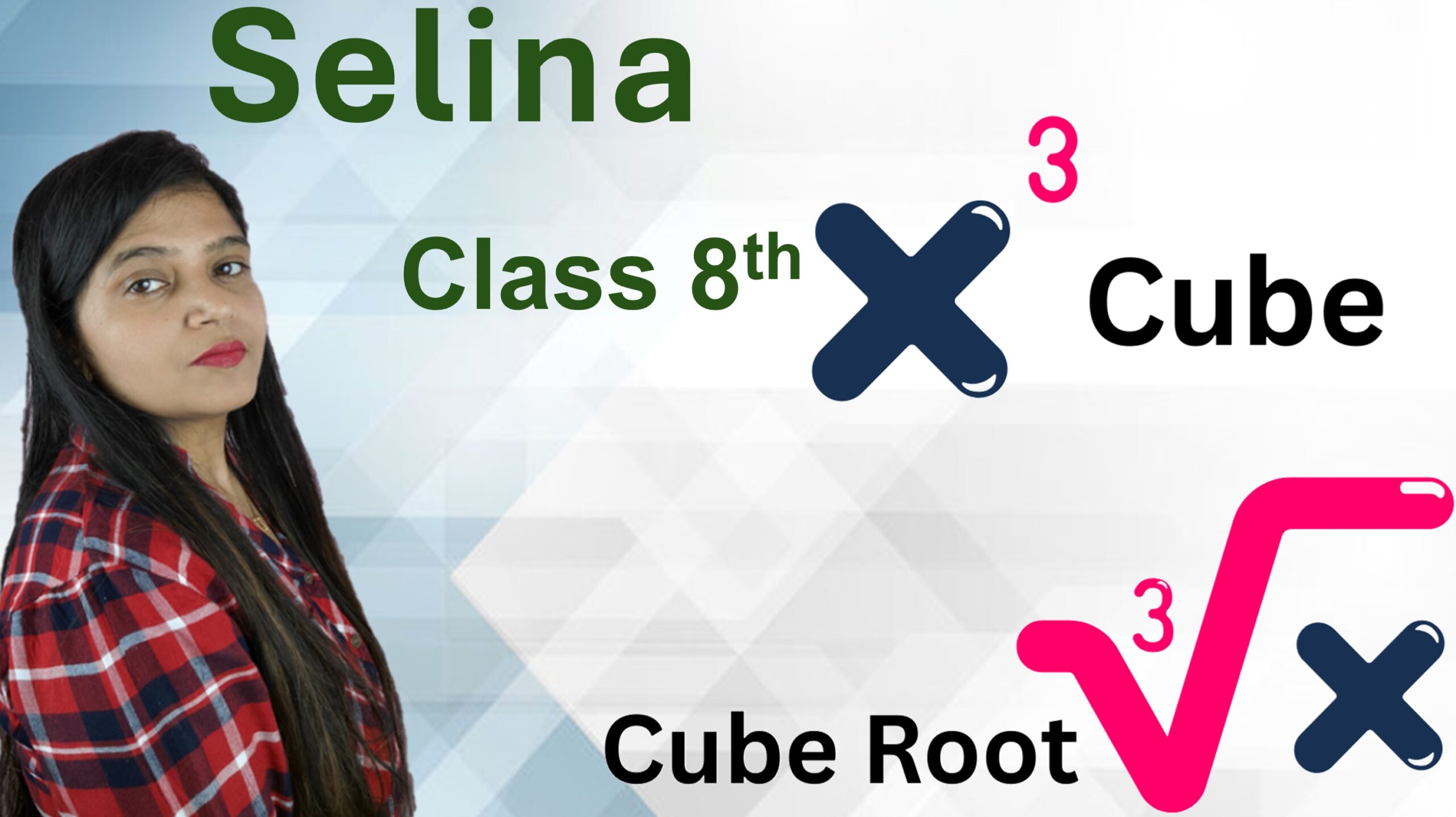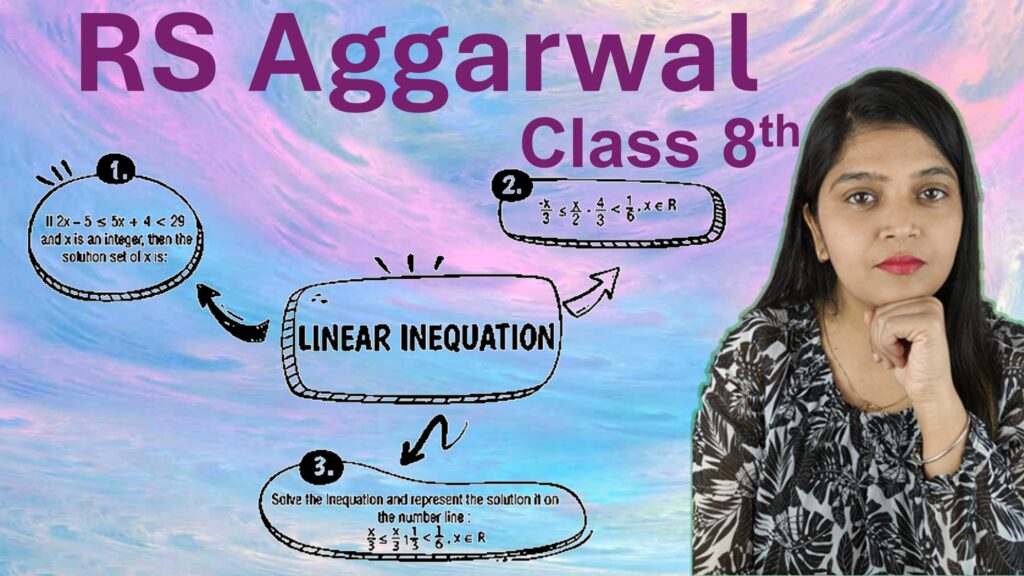Exercise: 4-A
Q1: Multiple Choice Type:
i. The cube of 0.5 is:
Step 1: Cube means multiplying the number by itself three times.
\[
(0.5)^3 = 0.5 \times 0.5 \times 0.5
\]Step 2: Multiply step-by-step:
\[
0.5 \times 0.5 = 0.25,\quad 0.25 \times 0.5 = 0.125
\]Answer: b. 0.125
ii. The cube of -4 is:
Step 1: Cube of -4 means:
\[
(-4)^3 = (-4) \times (-4) \times (-4)
\]Step 2: Multiply:
\[
(-4) \times (-4) = 16,\quad 16 \times (-4) = -64
\]Answer: c. -64
iii. The smallest number by which 72 must be multiplied to obtain a perfect cube is:
Step 1: Prime factorise 72:
\[
72 = 2 \times 2 \times 2 \times 3 \times 3 = 2^3 \times 3^2
\]Step 2: To make a cube, all prime powers should be multiples of 3.
\[
3^2 \Rightarrow \text{Needs one more 3 to become } 3^3
\]Step 3: Multiply by 3:
\[
72 \times 3 = 216,\quad 216 = 6^3
\]Answer: a. 3
iv. The smallest number by which 81 be divided to obtain a perfect cube is:
Step 1: Prime factorise 81:
\[
81 = 3 \times 3 \times 3 \times 3 = 3^4
\]Step 2: To make it a perfect cube, we need to make the power of 3 a multiple of 3.
\[
3^4 \div 3 = 3^3 = 27 \quad \text{(Perfect cube)}
\]Answer: b. 3
Q2: Find the cube of:
i. 7
Step 1:
\[
7^3 = 7 \times 7 \times 7 = 343
\
Answer: 343
ii. 11
Step 1:
\[
11^3 = 11 \times 11 \times 11 = 1331
\]Answer: 1331
iii. 16
Step 1:
\[
16^3 = 16 \times 16 \times 16 = 4096
\]Answer: 4096
iv. 23
Step 1:
\[
23^3 = 23 \times 23 \times 23 = 12167
\]Answer: 12167
v. 31
Step 1:
\[
31^3 = 31 \times 31 \times 31 = 29791
\]Answer: 29791
vi. 42
Step 1:
\[
42^3 = 42 \times 42 \times 43 = 74088
\]Answer: 74088
vii. 54
Step 1:
\[
54^3 = 54 \times 54 \times 54 = 157464
\]Answer: 157464
Q3: Find which of the following are perfect cubes?
i. 243
Step 1: Prime factorisation of 243:
\[
243 = 3 \times 3 \times 3 \times 3 \times 3 = 3^5
\]Step 2: To be a perfect cube, all prime powers must be multiples of 3.
\[
\text{But } 5 \text{ is not a multiple of 3}
\]Answer: Not a perfect cube
ii. 588
Step 1: Prime factorisation of 588:
\[
588 = 2 \times 2 \times 3 \times 7 \times 7 = 2^2 \times 3 \times 7^2
\]Step 2: Powers are not multiples of 3.
Answer: Not a perfect cube
iii. 1331
Step 1: Try cube root:
\[
\sqrt[3]{1331} = 11 \Rightarrow 11^3 = 1331
\]Step 2: Check by factorization:
\[
1331 = 11 \times 11 \times 11 = 11^3
\]Answer: Perfect cube
iv. 24000
Step 1: Prime factorisation:
\[
24000 = 2^7 \times 3 \times 5^3
\]Step 2: Powers of 2 and 3 are not multiples of 3:
\[
\text{2^7 → Not divisible by 3, and 3^1 → Not cube}
\]Answer: Not a perfect cube
v. 1728
Step 1: Prime factorisation:
\[
1728 = 2^6 \times 3^3
\]Step 2: All powers are divisible by 3
Step 3: Cube root:
\[
\sqrt[3]{1728} = 12,\quad \text{since } 12^3 = 1728
\]Answer: Perfect cube
vi. 1938
Step 1: Prime factorisation:
\[
1938 = 2 \times 3 \times 17 \times 19
\]Step 2: None of the powers are cubes.
Answer: Not a perfect cube
Q4: Find the cubes of:
i. 2.1
Step 1: Multiply 2.1 three times
\[
2.1 \times 2.1 = 4.41,\quad 4.41 \times 2.1 = 9.261
\]Answer: 9.261
ii. 0.4
Step 1: Multiply 0.4 three times
\[
0.4 \times 0.4 = 0.16,\quad 0.16 \times 0.4 = 0.064
\]Answer: 0.064
iii. 1.6
Step 1: Multiply 1.6 three times
\[
1.6 \times 1.6 = 2.56,\quad 2.56 \times 1.6 = 4.096
\]Answer: 4.096
iv. 2.5
Step 1: Multiply 2.5 three times
\[
2.5 \times 2.5 = 6.25,\quad 6.25 \times 2.5 = 15.625
\]Answer: 15.625
v. 0.12
Step 1: Multiply 0.12 three times
\[
0.12 \times 0.12 = 0.0144,\quad 0.0144 \times 0.12 = 0.001728
\]Answer: 0.001728
vi. 0.02
Step 1: Multiply 0.02 three times
\[
0.02 \times 0.02 = 0.0004,\quad 0.0004 \times 0.02 = 0.000008
\]Answer: 0.000008
vii. 0.8
Step 1: Multiply 0.8 three times
\[
0.8 \times 0.8 = 0.64,\quad 0.64 \times 0.8 = 0.512
\]Answer: 0.512
Q5: Find the cubes of:
i. \(\frac{3}{7}\)
Step 1: Cube numerator and denominator separately:
\[
\left(\frac{3}{7}\right)^3 = \frac{3^3}{7^3} = \frac{27}{343}
\]Answer: \(\frac{27}{343}\)
ii. \(\frac{8}{9}\)
Step 1: Cube numerator and denominator:
\[
\left(\frac{8}{9}\right)^3 = \frac{8^3}{9^3} = \frac{512}{729}
\]Answer: \(\frac{512}{729}\)
iii. \(\frac{10}{13}\)
Step 1: Cube numerator and denominator:
\[
\left(\frac{10}{13}\right)^3 = \frac{10^3}{13^3} = \frac{1000}{2197}
\]Answer: \(\frac{1000}{2197}\)
iv. \(1\frac{2}{7}\)
Step 1: Convert to improper fraction:
\[
1\frac{2}{7} = \frac{9}{7}
\]Step 2: Cube it:
\[
\left(\frac{9}{7}\right)^3 = \frac{729}{343} = 2\frac{43}{343}
\]Answer: \(2\frac{43}{343}\)
v. \(2\frac{1}{2}\)
Step 1: Convert to improper fraction:
\[
2\frac{1}{2} = \frac{5}{2}
\]Step 2: Cube it:
\[
\left(\frac{5}{2}\right)^3 = \frac{125}{8} = 15\frac{5}{8}
\]Answer: \(15\frac{5}{8}\)
Q6: Find the cubes of:
i. -3
Step 1: Cube of -3 means multiplying it three times:
\[
(-3)^3 = (-3) \times (-3) \times (-3)
\]Step 2: First two negative numbers give positive:
\[
(-3) \times (-3) = 9,\quad 9 \times (-3) = -27
\]Answer: -27
ii. -7
Step 1: Cube of -7:
\[
(-7)^3 = (-7) \times (-7) \times (-7) = 49 \times (-7) = -343
\]Answer: -343
iii. -12
Step 1: Cube of -12:
\[
(-12)^3 = (-12) \times (-12) \times (-12) = 144 \times (-12) = -1728
\]Answer: -1728
iv. -18
Step 1: Cube of -18:
\[
(-18)^3 = (-18) \times (-18) \times (-18) = 324 \times (-18) = -5832
\]Answer: -5832
v. -25
Step 1: Cube of -25:
\[
(-25)^3 = (-25) \times (-25) \times (-25) = 625 \times (-25) = -15625
\]Answer: -15625
vi. -30
Step 1: Cube of -30:
\[
(-30)^3 = (-30) \times (-30) \times (-30) = 900 \times (-30) = -27000
\]Answer: -27000
vii. -50
Step 1: Cube of -50:
\[
(-50)^3 = (-50) \times (-50) \times (-50) = 2500 \times (-50) = -125000
\]Answer: -125000
Q7: Which of the following are cubes of:
i. an even number
ii. an odd number.
216, 729, 3375, 8000, 125, 343, 4096 and 9261
i. 216
Step 1: Find cube root:
\[
\sqrt[3]{216} = \sqrt[3]{2 \times 2 \times 2 \times 3 \times 3 \times 3} = 2 \times 3 = 6
\]Step 2: 6 is an even number.
Answer: Even number
ii. 729
Step 1: Cube root:
\[
\sqrt[3]{729} = \sqrt[3]{3 \times 3 \times 3 \times 3 \times 3 \times 3} = 3 \times 3 = 9
\]Step 2: 9 is an odd number.
Answer: Odd number
iii. 3375
Step 1: Cube root:
\[
\sqrt[3]{3375} = \sqrt[3]{3 \times 3 \times 3 \times 5 \times 5 \times 5} = 3 \times 5 = 15
\]Step 2: 15 is an odd number.
Answer: Odd number
iv. 8000
Step 1: Cube root:
\[
\sqrt[3]{8000} = \sqrt[3]{2 \times 2 \times 2 \times 2 \times 2 \times 2 \times 5 \times 5 \times 5} \\
= 2 \times 2 \times 5 = 20
\]Step 2: 20 is an even number.
Answer: Even number
v. 125
Step 1: Cube root:
\[
\sqrt[3]{125} = \sqrt[3]{5 \times 5 \times 5} = 5
\]Step 2: 5 is an odd number.
Answer: Odd number
vi. 343
Step 1: Cube root:
\[
\sqrt[3]{343} = = \sqrt[3]{7 \times 7 \times 7} = 7
\]Step 2: 7 is an odd number.
Answer: Odd number
vii. 4096
Step 1: Cube root:
\[
\sqrt[3]{4096} = \sqrt[3]{2 \times 2 \times 2 \times 2 \times 2 \times 2 \times 2 \times 2 \times 2 \times 2 \times 2 \times 2} \\
= 2 \times 2 \times 2 \times 2 = 16
\]Step 2: 16 is an evan number.
Answer: Even number
viii. 9261
Step 1: Cube root:
\[
\sqrt[3]{9261} = \sqrt[3]{3 \times 3 \times 3 \times 7 \times 7 \times 7} = 3 \times 7 = 21
\]Step 2: 21 is an odd number.
Answer: Odd number
Q8: Find the least number by which 1323 must be multiplied that the product a perfect cube.
Step 1: Find the prime factorisation of 1323
\[
1323 \div 3 = 441 \quad \Rightarrow \quad 441 \div 3 = 147 \quad \Rightarrow \quad 147 \div 3 = 49 \quad \Rightarrow \quad 49 = 7 \times 7
\]
So,
\[
1323 = 3 \times 3 \times 3 \times 7 \times 7 = 3^3 \times 7^2
\]Step 2: For a number to be a perfect cube, all prime powers must be multiples of 3
Here,
\[
3^3 \text{ is a cube already, but } 7^2 \text{ is not}
\]Step 3: Multiply by one more 7 to make exponent of 7 equal to 3:
\[
1323 \times 7 = 9261
\]Now:
\[
9261 = 3^3 \times 7^3 = (3 \times 7)^3 = 21^3
\]Answer: 7
The least number is 7 to make 1323 a perfect cube.
Q9: Find the smallest number by which 8768 must be multiplied that the product a perfect cube.
Step 1: Perform prime factorisation of 8768
We start by dividing by 2:
\[
8768 \div 2 = 4384 \quad \div 2 = 2192 \quad \div 2 = 1096 \quad \div 2 = 548 \quad \div 2 = 274 \quad \div 2 = 137
\]
Now 137 is a prime number.
So, prime factors of 8768 are:
\[
8768 = 2^6 \times 137
\]Step 2: Group the powers to check for cube formation
We have:
– \(2^6\) → cube-ready (since \(6\) is a multiple of 3)
– \(137^1\) → not cube-ready
Step 3: 137 is the least number by which 8768 must be multiplied that the product a perfect cube.
Answer: 137
Q10: Find the smallest number by which 27783 should be multiplied to get a perfect cube number.
Step 1: Find the prime factorisation of 27783
Check divisibility by 3:
\[
27783 \div 3 = 9261 \quad \div 3 = 3087 \quad \div 3 = 1029 \quad \div 3 = 343
\]
Now,
\[
343 = 7 \times 7 \times 7 = 7^3
\]So, we have:
\[
27783 = 3^4 \times 7^3
\]Step 2: To make a perfect cube, all powers must be multiples of 3
– \(7^3\) is already a perfect cube
– \(3^4\) → needs to become \(3^6\) (next multiple of 3 after 4)
→ So we must multiply by \(3^2 = 9\)
Step 3: Multiply by 9:
\[
27783 \times 9 = 250047
\]
Check:
\[
250047 = (3^6) \times (7^3) = (3^2 \times 7)^3 = (63)^3
\]Answer: 9
The smallest number is 9 to make 27783 a perfect cube.
Q11: With what least number should 8640 be divided so that the quotient is a perfect cube?
Step 1: Perform prime factorisation of 8640
\[
8640 = 2^6 \times 3^3 \times 5
\]Step 2: For a number to be a perfect cube, all prime exponents must be multiples of 3
We analyse each prime power:
– \(2^6\) ✅ (6 is a multiple of 3)
– \(3^3\) ✅ (3 is a multiple of 3)
– \(5^1\) ❌ (1 is not a multiple of 3)
Step 3: To make it a perfect cube, we must remove \(5^1\) (as 1 is not divisible by 3)
So, divide 8640 by 5:
\[
8640 \div 5 = 1728
\]Now,
\[
1728 = 2^6 \times 3^3 = (2^2 \times 3)^3 = (12)^3
\]Step 4: The quotient is a perfect cube.
Answer: 5
The least number to divide 8640 by to get a perfect cube is 5.
Q12: Which is the smallest number that should be multiplied to 77175 to make it a perfect cube?
Step 1: Find the prime factorisation of 77175
Divide by 5:
\[
77175 \div 5 = 15435 \quad \div 5 = 3087
\]Now divide 3087 by 3 repeatedly:
\[
3087 \div 3 = 1029 \quad \div 3 = 343
\]Now factor 343:
\[
343 = 7 \times 7 \times 7 = 7^3
\]So the full factorisation:
\[
77175 = 3^2 \times 5^2 \times 7^3
\]Step 2: For a number to be a perfect cube, each exponent must be a multiple of 3
We need to adjust:
– \(3^2 \rightarrow\) multiply by one more 3 to make \(3^3\)
– \(5^2 \rightarrow\) multiply by one more 5 to make \(5^3\)
– \(7^3\) is already a perfect cube ✅
Step 3: Multiply by \(3 \times 5 = 15\)
\[
77175 \times 15 = 1157625
\]Now:
\[
1157625 = (3 \times 5 \times 7)^3 = (105)^3
\]Answer: 15
The smallest number to multiply 77175 and make it a perfect cube is 15.






Leave a Comment